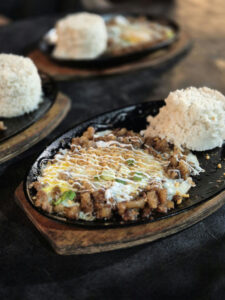The road to Pampanga always feels like driving into the heart of Filipino cuisine. As soon as I left Manila and the highway opened toward Angeles, my stomach began to stir with excitement — the kind only a true Pampanga food trip can inspire. Pampanga isn’t just known for its dishes; it’s known for its cooks, its traditions, and the way food becomes a language of pride. Every meal here feels like being welcomed into someone’s home.
First Stop: Angeles City and the Home of Sisig
 My Pampanga food trip began in Angeles City, where the morning was warm and bright, and the scent of grilled meat drifted through the streets. I made my way to the iconic Aling Lucing’s, the birthplace of the legendary Kapampangan sisig. The sound of sizzling pork filled the air as I sat by a table near the open kitchen. When the hot plate finally arrived, steam rising like a promise, I took my first bite — crunchy, savory, smoky, and wonderfully tangy.
My Pampanga food trip began in Angeles City, where the morning was warm and bright, and the scent of grilled meat drifted through the streets. I made my way to the iconic Aling Lucing’s, the birthplace of the legendary Kapampangan sisig. The sound of sizzling pork filled the air as I sat by a table near the open kitchen. When the hot plate finally arrived, steam rising like a promise, I took my first bite — crunchy, savory, smoky, and wonderfully tangy.
Kapampangans know how to balance flavors with instinctive confidence. The vinegar cut through the richness, the onions added sweetness, and the calamansi brightened everything. I ate slowly, savoring each forkful until only faint crackles were left on the plate.
After breakfast, I wandered through Angeles’ quiet streets, lined with heritage houses and small eateries. It felt like every corner had a story — and every story seemed to include food.
Cooking With Heart: Bringhe and Kapampangan Kitchens
By midday, my Pampanga food trip took me to a family-run spot known for its bringhe, often described as Pampanga’s version of paella. But bringhe has its own character — fragrant with turmeric, studded with chicken and vegetables, and cooked in coconut milk that turns each grain of rice into silky gold. The cook invited me to step into their rustic kitchen, where clay pots sat over wood fires and banana leaves softened in the heat.
As she stirred the rice, she spoke about how bringhe is often served during fiestas and family celebrations. “It’s food for sharing,” she said, smiling as she lifted the lid to reveal the steam rising like incense. When I tasted it, the flavors felt both familiar and special — earthy, creamy, and deeply comforting. In Pampanga, the kitchen isn’t just a space for cooking. It’s where generations gather and where traditions pass from one pair of hands to the next.
Market Wanderings in San Fernando
From Angeles, I drove to San Fernando, stopping by the public market where piles of fresh produce, local delicacies, and handmade sweets filled the stalls. The vendors greeted me with the kind of cheer that feels instantly familiar. “Tikman mo!” they urged, offering small bites of pastillas, tocino, and various kakanin.
The colors alone were enough to make me reach for my wallet — deep purple ube, bright green pandan, and golden cassava cakes sitting side by side like jewels in the morning light. I bought a small tray of sapin-sapin and ate it as I wandered deeper into the market, its chewy layers melting slowly on my tongue. Markets like this are the soul of any Pampanga food trip, reminding visitors that the best flavors come from fresh, local ingredients.
Tibok-Tibok and Sweet Endings
No Pampanga food trip ends without dessert. The treat I was most excited for was tibok-tibok, a silky carabao milk pudding topped with latik. In a small home-based eatery, I watched as the cook whisked the mixture in a kaserola, her movements practiced and calm. The pudding thickened slowly, filling the kitchen with a scent both sweet and milky, like a childhood memory returning.
When she placed a freshly made slice before me, still warm and tender, I let the first bite linger. It tasted pure — clean, rich, and lightly caramelized by the latik. Dessert in Pampanga has a way of speaking directly to the heart.
Roadside Discoveries and Local Conversations
 One of my favorite parts of any Pampanga food trip is pulling over at roadside eateries — the kind with plastic chairs, handwritten menus, and dishes cooked with soul. I stopped at a small carinderia where the owner served me pork asado and kilayin, flavors sharp with vinegar and spices. The place was humble, but the food was unforgettable.
One of my favorite parts of any Pampanga food trip is pulling over at roadside eateries — the kind with plastic chairs, handwritten menus, and dishes cooked with soul. I stopped at a small carinderia where the owner served me pork asado and kilayin, flavors sharp with vinegar and spices. The place was humble, but the food was unforgettable.
As I ate, the owner shared how her mother taught her to cook, how recipes evolve with each generation, and how Kapampangans pride themselves on food that surprises and satisfies. She told me, “Dito, bawal ang ‘pwede na.’ Kailangan masarap.” (“Here, ‘good enough’ is not allowed. It has to be delicious.”) I believed her with every bite.
What Makes Kapampangan Cuisine Special
Throughout the day, I realized that Pampanga’s culinary strength doesn’t come from extravagance. It comes from mastery — from cooks who know their ingredients deeply, who aren’t afraid to experiment, and who carry their heritage with pride. It’s a cuisine shaped by creativity, resilience, and a fearless love for flavor.
As I drove back to Manila with bags full of pasalubong and a heart full of gratitude, I understood why Pampanga is called the food capital of the Philippines. It isn’t just because the food tastes incredible — it’s because every meal carries a story, every cook carries a legacy, and every bite reminds you that food is a connection to people, history, and home.
This Pampanga food trip wasn’t just a journey across towns — it was a journey through tradition preserved in kitchens and recreated every day. Pampanga’s flavors are bold, generous, and filled with heart. And long after the plates are cleared, the stories stay with you.


